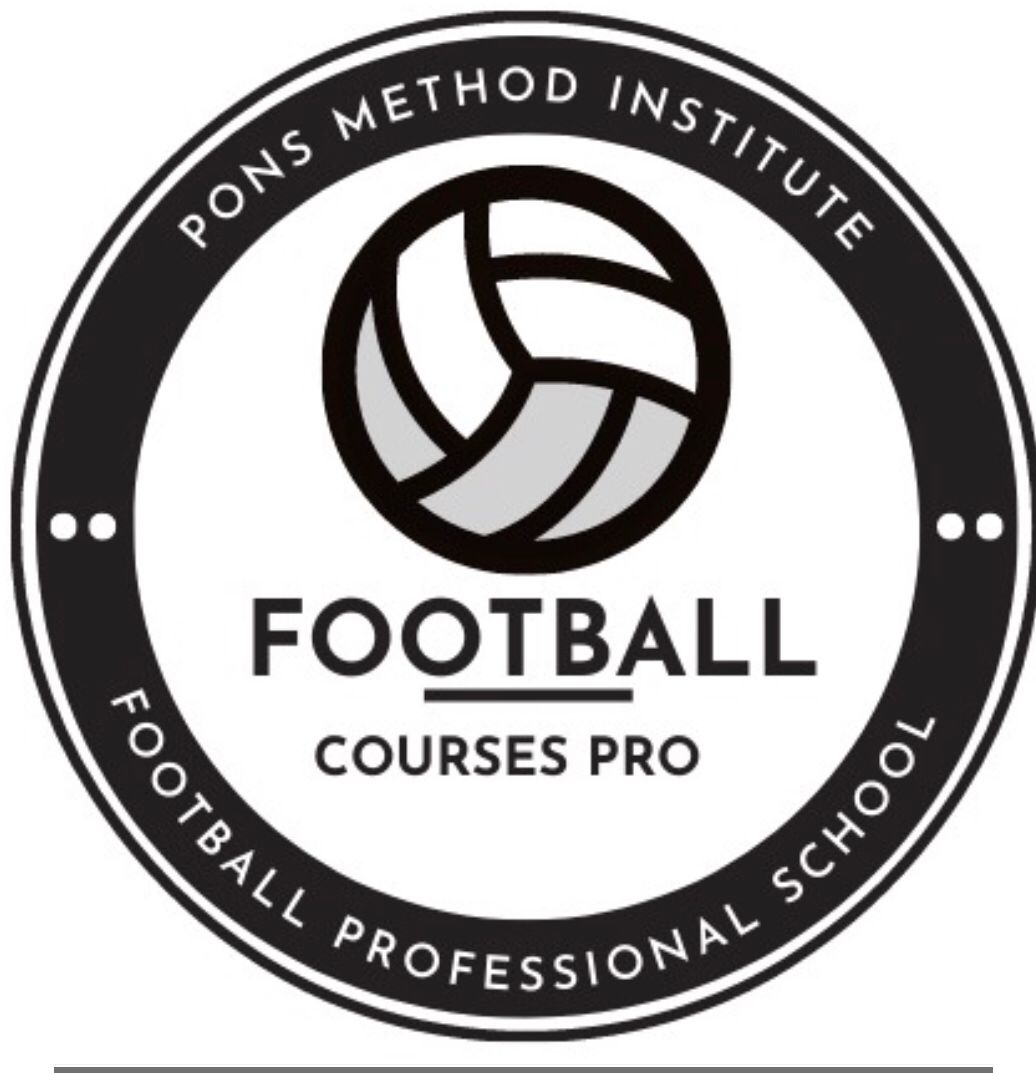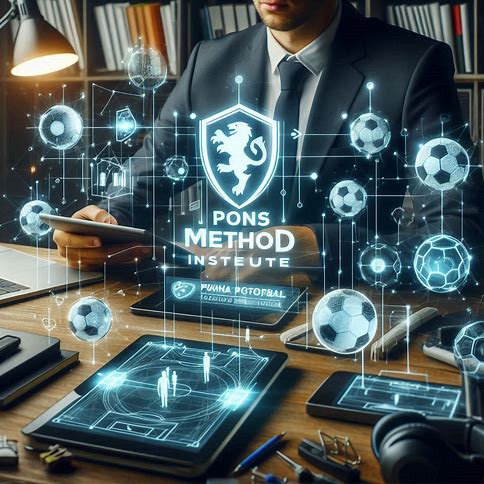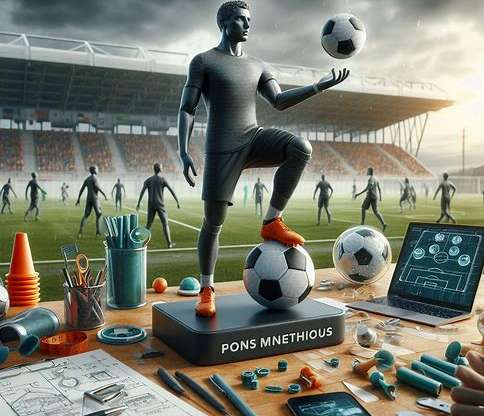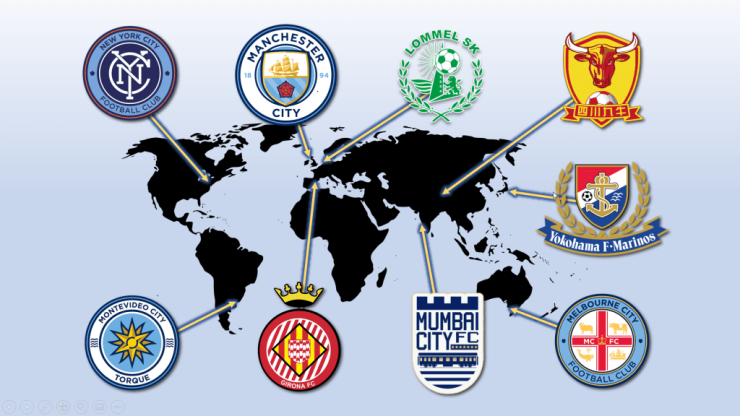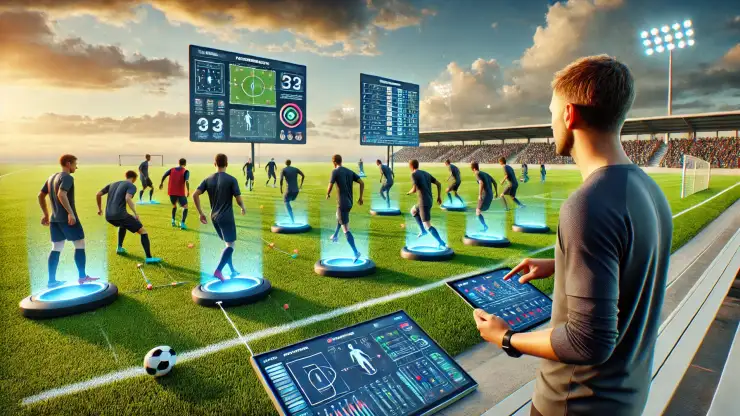The Pons Method could be a decisive factor in taking Multi-Club Ownership (MCO) systems to the next level. Its focus on end-to-end management, process automation and talent development fits perfectly with the need of these conglomerates to maximise player and team performance at multiple levels.
How does the Pons Method fit into the MCO?
Currently, many of these groups (City Football Group, Red Bull, 777 Partners) prioritise business and investments, but often lack a homogeneous methodology that ensures talent development consistently across all their clubs. The Pons Method offers a clear roadmap to correct this.
- Automation of Tactical and Technical Development (FPM Principle)
Current Problem:
Players are sent from one club to another, but not always under the same methodology. This causes some not to adapt quickly to the new tactical or physical environment. Improvement with the Pons Method:
Offensive and Defensive Automation: Automated and transferable game patterns are created between clubs. This means that a player who is trained in South America can adapt without problems to the European team in the group, since the tactical concepts are the same.
Example: If Red Bull implemented the Pons Method, all its clubs (Salzburg, Leipzig, Bragantino) would play with automated offensive and defensive principles, facilitating the progression of promising young players.
- Specific Specialization and Synchronicity of the Technical Staff
Current Problem:
Some clubs within the MCO have different standards of physical, tactical and medical preparation. The staff varies in quality, affecting the development of players.
Improvement with the Pons Method:
Subprinciple of Specific Specialization of the Technical Staff: Clear roles are assigned to each member of the technical staff with total specialization in their area.
Subprinciple of Progressive Synchronicity: All staff, from the youth team to the first team, work with the same principles and tactical language.
Tangible Example: City Football Group could ensure that all its clubs have a uniform approach to physical and tactical preparation, elevating long-term performance.
- Creating Football-Specific Rehabilitation Processes
Current Problem:
Injured players often go through generic rehabilitation programs, delaying their competitive reintegration.
Improvement with the Pons Method:
Functional and Progressive Rehabilitation Sub-Principle: Players receive a rehabilitation program specifically designed for their tactical and physical role on the field.
Impact on the MCO:
Clubs can reduce the time that key players are out of action, maximizing their market value and avoiding depreciation.
Specialized rehabilitation centers are created within the MCO network, facilitating transcontinental recovery.
- Game Model Optimization and Predictive Analysis
Current Problem:
Many clubs lack flexible game models and often the coach imposes his system without considering the players’ profiles.
Improvement with the Pons Method:
Rival-Based Adjustment Sub-Principle: The game model is analyzed and adapted based on the opposing team and the available strengths.
Predictive Analysis Sub-Principle: The Pons Method proposes the use of Big Data and simulations to anticipate opponent patterns and adjust tactics in real time.
Example: Red Bull could optimize its high pressing system based on predictions of the opponent’s performance, which would improve control of critical matches.
- Specific Fragmentation of Training
Current Problem:
Training sessions are often generic or not adapted to the different phases of the game (attack, defense, transition).
Improvement with the Pons Method:
Phase-Fragmented Training Sub-Principle: Each training session is divided and focused on improving specific phases of the game, integrating real situations that players face on the field.
Example: City Football Group can establish specific training sessions for fast transitions or low block pressing, replicating common patterns in modern football.
- Sensory and Perceptual Integration (SPI)
Current Problem:
Player development often focuses only on the physical and tactical, leaving aside perception and quick decision making.
Improvement with the Pons Method:
Subprinciple of Perception of the Environment and Visomotor Synchronization: Players train to improve their peripheral vision and tactical perception, increasing their performance under pressure.
Example: A young player sent to Girona (City Football Group) could receive specialized training in tactical perception and decision making, preparing him for a move to Manchester City.
Tangible Benefits for MCOs by Implementing the Pons Method:
Increased Player Value: Developing talent with advanced methodologies increases market value.
Smoother Player Transition: Players who change clubs within the MCO adapt quickly to the new environment.
Injury Reduction: Specific rehabilitation programs shorten the time off work.
Consistent Sporting Success: Tactical automation and staff development allow all clubs to compete at the highest level.
Clear Identity and Style: A uniform football identity is created throughout the network of clubs, similar to the famous “Barça DNA”.
Conclusion:
The Pons Method not only optimizes player development, but creates clear synergies in an MCO system, ensuring that each club contributes to the overall development of the group. Investing in this methodology would mean not only competing better on the sporting level, but multiplying the value of the most important assets: the players.
- Developing Talent from the Grassroots (Youth and Youth)
Current Problem:
Many clubs within MCO systems do not fully utilize their academies or subsidiaries, and youth talents are not given clear opportunities to progress.
Often, there is a disconnect between the youth and first team, leading to losing players with potential.
Improvement with the Pons Method:
Sub-principle of Situational Transfer and Modular Training:
Young players receive training adapted to different game scenarios (possession, high pressing, transitions).
A clear progression path is created: from the academy to the first team or to other clubs in the group.
Example:
Red Bull can implement uniform training programs from the youth categories of Bragantino to Leipzig, ensuring that youngsters arrive at the first team with a complete tactical understanding.
- Mentality and Psychological Resilience
Current Problem:
The mental aspect is often neglected in player development.
Young footballers, when moving from one club to another, may lose confidence or fail to adapt to the pressure of elite football.
Improvement with the Pons Method:
Subprinciple of Mental Strengthening Under Pressure and Visualisation of Successful Scenarios:
Players work on mental simulations of critical situations (penalties, close matches, comebacks).
Mental resilience is fostered with training that exposes the player to controlled high-pressure conditions.
Example:
City Football Group can use the PonsMethod to mentally prepare its young players in Girona, ensuring that they arrive at the first team ready to face big challenges.
- Coordination of Defensive and Offensive Roles (Line Synchronisation)
Current Problem:
Young players often do not have clarity about their defensive or offensive roles in different formations, which affects collective play.
Improvement with the Pons Method:
Subprinciple of Alignment of the Game in Transition and Coordination of Lines:
Players learn to synchronize their movements with the different lines of the team (defense, midfield, attack).
Defensive and attacking patterns are created that adapt to the moment of the match and the tactical formation.
Example:
INEOS (Nice and Lausanne) can establish uniform tactical patterns, allowing full-backs or pivots to understand their roles in an automated way in any club of the group.
- Innovation and Predictive Analysis
Current Problem:
Although many clubs use technology and data, there is no integrated structure that allows all clubs within the MCO to benefit from these analyses.
Improvement with the Pons Method:
Subprinciple of Using Data for Anticipation and Dynamic Tactical Adaptation:
Implement predictive analysis software in all clubs of the MCO.
Performance data is shared and analysed centrally, allowing for prediction of player development and anticipation of potential performance drops.
Example:
777 Partners could centralise data analysis for Genoa, Vasco da Gama and Standard Liège, allowing for internal transfers based on clear performance metrics.
- Synergy between Clubs (Staff and Players)
Current Problem:
The different clubs within the MCO do not always have fluid communication or share technical and tactical resources.
Improvement with the Pons Method:
Subprinciple of Fluid Communication and Clarity of Roles in the Technical Staff:
A system is established where coaches and fitness trainers from all clubs collaborate on shared projects.
Coach exchanges are encouraged between clubs in the MCO so that everyone learns the global tactical model.
Example:
Eagle Football Holdings (Lyon, Botafogo, Crystal Palace) can send coaches and analysts between clubs, ensuring tactical coherence and uniform development of talent.
- Creating Individual Tactical Strengths
Current Problem:
Young players are trained in a general way, but they are not given specific roles where they can excel more quickly.
Improvement with the Pons Method:
Subprinciple of Personalization of Tactical Training and Application in Real Situations:
Each player receives specific training to enhance his tactical strength (dribbling, aerial play, high pressing).
Training sessions focused on his weaknesses are established to improve overall performance.
Example:
A fast winger in Nice (INEOS) can receive specific training in dribbling and finishing to quickly adapt to the first team or be transferred to another club in the group.
Tangible Impact on the MCO: Clear Benefits with the Pons Method
Higher Return on Investment (ROI):
Young players develop faster and their market value increases.
Unnecessary signings are reduced thanks to the internal development of talent.
Widespread Sporting Success:
All clubs within the MCO compete with greater consistency.
A shared winning culture is created at all levels of the club.
Resource Optimization:
Centralization of data, staff and technology.
Adaptation time for players and coaches is reduced.
Global Reputation:
Clubs within the MCO become references for player development.
Investment in young talent improves the perception of the group in the global market.
The Pons Method offers a real competitive advantage to any MCO system, not only increasing the value of its players, but transforming the way clubs work and collaborate.
- Development of a Football DNA for the Group
Current Problem:
Many MCO groups lack a clear tactical identity. Each club may have a different style of play, which makes it difficult to develop talent evenly and affects the integration of players between clubs.
Improvement with the Pons Method:
Subprinciple of Alignment of the Rhythm of Play and Positional Empathy:
A football DNA is established that defines how all clubs within the group play.
The style of play is adapted to the player’s strengths, but maintaining basic principles of possession, high pressure or fast transitions in all categories.
Example:
City Football Group could further consolidate its positional and offensive style of play in all its clubs. Thus, a player trained in Girona or Melbourne City can quickly integrate into Manchester City without wasting time in adaptation.
- Gamification and Internal Motivation
Current Problem:
Club academies and subsidiaries often have repetitive and uninspiring training sessions, which can affect the motivation of young players.
Improvement with the Pons Method:
Subprinciple of Progressive Gamification and Playful Competition:
Training sessions incorporate elements of competition and reward, replicating real match situations and adding incentives for individual and collective performance.
Interactive panels, game simulators and technology are integrated to make training more dynamic.
Example:
In clubs such as Botafogo (Eagle Football Holdings), youth training sessions could include simulators that evaluate decision-making in real time, improving competitiveness and keeping motivation high.
- Specific Physical Preparation and Individual Adaptation
Current Problem:
Physical preparation programs are often generic and not adapted to the individual needs of each player. This affects performance and increases the risk of injury.
Improvement with the Pons Method:
Subprinciple of Sustainable Individualisation of Training (SIT):
Each player receives fitness plans tailored to their tactical role (a full-back will have different needs than a midfielder).
Workload and fatigue are monitored to prevent injuries, ensuring that the player maintains peak performance throughout the season.
Example:
In Nice (INEOS), a full-back with a high match load could receive specific active recovery training, while a developing forward receives explosive strength sessions.
- Progression of Decision Making (Neuronal Plasticity and Mirror Neurons)
Current Problem:
Many young players reach the first team with deficiencies in quick and accurate decision making, which limits their impact in elite competitions.
Improvement with the Pons Method:
Subprinciple of Mirror Neuron Stimulation and Neuronal Plasticity:
Players participate in visualisation and tactical simulation training to improve their decision making without the need to accumulate excessive minutes on the field.
Visual repetition and observation of game patterns accelerate your ability to respond in real situations.
Example:
A Vasco da Gama (777 Partners) player could view dozens of high-level matches, simulating decisions in different phases of the game, allowing him to adapt quickly when he moves up to a European club in the group.
- Optimizing Transition Play (Offensive and Defensive)
Current Problem:
Most teams within the MCO do not work in a coordinated manner on rapid transitions, which generates weaknesses in defense and loss of offensive effectiveness.
Improvement with the Pons Method:
Subprinciple of Fragmentation of Transitions and Rapid Play:
Training sessions are fragmented to work exclusively on attack-defense transitions and vice versa, optimizing the team’s response speed in those critical moments.
Example:
RB Leipzig (Red Bull) could develop intensive transition sessions with Red Bull Salzburg players, ensuring that both clubs master high pressing and quick exits.
- Set Piece Optimization (Differential Factor in European Competition)
Current Problem:
Set pieces are underused or poorly trained, which reduces scoring opportunities in key situations.
Improvement with the Pons Method:
Subprinciple of Scenario Analysis and Set Piece Automation:
Specific patterns of corners, fouls and penalties are created based on data analysis of the opponent.
Players practice in simulated scenarios that replicate high pressure situations (final minutes or tiebreakers).
Example:
Standard Liège (777 Partners) could specialize in offensive corner plays, becoming one of the most effective teams in set pieces within the group.
- Inclusion of Critical Scenario Simulation
Current Problem:
Many clubs do not train critical situations such as playing with 10 players or coming back in the last minutes.
Improvement with the Pons Method:
Subprinciple of Simulation of Critical Scenarios:
Extreme situations are replicated during training sessions so that players learn to manage pressure and make quick decisions under stress.
Example:
Genoa (777 Partners) could implement sessions where they simulate being down 1-0 with 10 players, practicing comebacks and tight defense.
General Conclusion: A Quality Leap for the MCO
The Pons Method not only raises sports performance, but also creates a homogeneous and automated structure for the development of talent in all clubs within the MCO system.
🔹 Greater consistency in sports results.
🔹 Increase in the market value of players.
🔹 Reduction in adaptation times and injuries.
🔹 Strengthening of the group’s football identity.
In short, the Pons Method transforms the MCO from a network of clubs to a true global talent factory.
- Sustainability and Ethics in MCO Growth
Current Issue:
The aggressive expansion of some MCOs can lead to criticism of unethical practices, such as exploiting smaller clubs or ignoring local needs.
In some cases, feeder clubs lose identity and become mere exporters of talent without a culture of their own.
Improvement with the Pons Method:
Subprinciple of Resource Optimization and Fair Play Education:
The Pons Method introduces sustainability and values education programs, ensuring that clubs maintain their local identity and are aligned with an ethical development philosophy.
The development of local talent is promoted, balancing international recruitment with respect for the youth academy and the roots of the club.
Example:
Eagle Football Holdings could develop community integration programs in Botafogo and Lyon, ensuring that both clubs grow without losing their cultural essence.
- Creating Football Schools Under a Single Philosophy
Current Problem:
Many MCOs have scattered youth academies, without a unified philosophy or standardized training processes.
Improvement with the Pons Method:
Subprinciple of Creating Unified Training Models:
A network of academies is established with the same training methodology, based on the automation of technical, tactical and physical processes.
The academies share talent assessment protocols, ensuring that players trained at any club in the group have a similar level of preparation.
Example:
City Football Group could implement a standardized global academy, with headquarters in Girona, Montevideo and Melbourne, ensuring that each academy functions as a reflection of the Manchester City training system.
- Creating Individualized Progression Lines for Players
Current Problem:
Many players within MCO systems stagnate or do not receive enough opportunities in the first team, which slows down their development.
Improvement with the Pons Method:
Sub-principle of Integration of Individual Progress:
Each player receives a personalised career plan, which includes loans to specific MCO clubs where he can continue his development without being relegated to the bench.
Quarterly performance evaluations are carried out, adjusting the plan according to his progress and tactical needs.
Example:
INEOS could create plans for a Lausanne youth player to move to OGC Nice, with detailed monitoring to ensure playing time and constant physical/tactical development.
- Creation of a Technology Hub for All MCO Clubs
Current Problem:
Data analysis, GPS and tactical tracking technology is not always available in all clubs in the same MCO, which creates inequalities.
Improvement with the Pons Method:
Sub-principle of Integration of Analysis Tools:
A centralised technology hub is created, where all MCO clubs access the same player analysis and evaluation tools.
This allows each player’s performance to be monitored in real time, sharing metrics
- Skill Transfer Between Clubs in the MCO
Current Problem:
Talent is often wasted in a single role. A player can be used solely as a winger or full-back without exploring other skills.
Improvement with the Pons Method:
Subprinciple of Situational Skill Transfer:
Players are encouraged to train in multiple positions and roles, ensuring they can contribute in different tactical schemes.
Players rotate between clubs where they are trained in secondary roles (for example, a full-back as a centre-back or winger), increasing their tactical and market value.
Example:
City Football Group could train Melbourne City players in multiple positions, ensuring they can adapt to Girona or Troyes without losing effectiveness.
Ultimate Benefit: Consolidate a Global Model of Success
By integrating the Pons Method, MCO systems would not only gain sporting advantages, but would create a global factory of football talent.
🔹 Increased player value: Better development means higher sales and better performance.
🔹 Global competitiveness: All clubs within the MCO can compete at an elite level.
🔹 Resource optimization: Centralization of technology, staff and data.
🔹 Unique football identity: A homogeneous tactical DNA is established in all clubs.
The Pons Method not only improves sporting performance, but transforms the MCO into a self-sufficient ecosystem that generates talent, success and sustainable benefits over time.
- Implementation of Leadership Programs and Winning Culture
Current Problem:
In many clubs within the MCO, there is a lack of solid leadership in the locker room or in the coaching staff, which affects collective performance at key moments.
Teams lack a shared culture of success, generating competitive inconsistencies.
Improvement with the Pons Method:
Subprinciple of Leadership and Strengthening the Collective Mentality:
Leadership programs are developed for key players and coaches, focusing on emotional management, decision-making and group cohesion.
The creation of leading captains in each club is encouraged, who become referents and transmitters of the MCO’s winning culture.
Emerging leaders rotate between clubs in the group, reinforcing the feeling of belonging and building a unified identity.
Example:
INEOS could implement a leadership program between Nice and Lausanne, where young captains and coaches are trained in leadership and management of sports crises to replicate it throughout the network of clubs.
- Creation of B and Subsidiary Teams with Real Competitive Models
Current Problem:
Many B or subsidiary clubs function as training spaces, but they do not have enough competitiveness to prepare players for the first level.
Improvement with the Pons Method:
Subprinciple of Simulation of Real Competition in Subsidiaries:
B teams and subsidiaries are integrated into high-intensity competitions, where players train under conditions similar to those of the first team.
Internal tournaments are organized between subsidiaries of different clubs within the MCO, generating direct competition and international exposure for young talents.
Example:
Red Bull could organize subsidiary tournaments between Bragantino, Salzburg and Leipzig, promoting competition and direct progression of players towards the first team.
- Implementation of High Performance Centers for Recovery and Physical Optimization
Current Problem:
Recovery from injuries and physical development is not standardized, and players take longer to return to their maximum level.
Improvement with the Pons Method:
Subprinciple of Specialized Recovery Centers (Biofeedback and Emotional Regulation):
Recovery and high performance centers are created exclusively for the MCO clubs.
These centres not only focus on physical rehabilitation, but also on emotional and mental regulation of players during the recovery process.
Neuroscience techniques are applied to accelerate post-injury mental recovery.
Example:
777 Partners could establish a high-performance centre in Europe, where players from Genoa, Hertha BSC and Standard Liège receive specialised recovery under a single model.
- Creating Critical Scenarios in Training
Current Problem:
Players rarely train under conditions that simulate real critical moments, such as defending a minimal lead or coming back in the last minutes.
Improvement with the Pons Method:
Subprinciple of High Pressure Scenario Simulation:
Training sessions that replicate match scenarios under extreme pressure are incorporated.
This includes training where players defend with 10 players or practice set pieces with limited time.
Example:
City Football Group could implement these simulations in Girona or Troyes, ensuring that players are prepared for highly competitive scenarios when they arrive at Manchester City.
- Promoting Collective Play and Pattern Automation
Current Problem:
Although some clubs share certain tactical principles, the automation of offensive and defensive patterns is not synchronized across the MCO network.
Improvement with the Pons Method:
Subprinciple of Automation of Offensive and Defensive Patterns:
Automated sequences of play are created that each club in the group trains regularly, ensuring a fluid progression of players from one team to the other.
Defense-attack transitions are practiced identically across all clubs, facilitating the integration of players at any level.
Example:
Red Bull could implement a pressing-after-loss pattern that all of its clubs practice, allowing any player from Salzburg, Bragantino, or Leipzig to immediately fit into the first team.
- Strategic Expansion into New Markets with Uniform Training
Current Problem:
Expansion into new markets (South America, Asia, Africa) is not always accompanied by a homogeneous methodology, which affects the quality of locally trained talent.
Improvement with the Pons Method:
Sub-principle of Uniform Training in Emerging Markets:
Academies and teams are established with identical training to that of the main clubs in the MCO.
It is ensured that young players receive elite training from the beginning, facilitating their transition to European clubs.
Example:
INEOS could develop academies in Africa with European methodology, ensuring that players trained at Racing Abidjan are ready to integrate at Nice or Lausanne.
- Tangible Results and Return on Investment
Final Benefit for the MCO with the Pons Method:
Incremental Value of Players:
Better trained players with greater tactical versatility will have a higher market value.
International Competitiveness:
Clubs within the MCO become globally competitive, successfully participating in international tournaments.
Long-Term Sustainability:
Developing internal talent reduces dependence on expensive signings and guarantees constant income from player sales.
Global Brand Strengthening:
Clubs within the MCO become associated with an elite training identity, attracting young players from around the world.
Conclusion: The Future of the MCO under the Pons Method
Implementing the Pons Method in a Multi-Club Ownership system transforms the network of clubs into an efficient and sustainable ecosystem, where talent flows, develops and generates tangible results both in sport and economic terms.
Enviar
